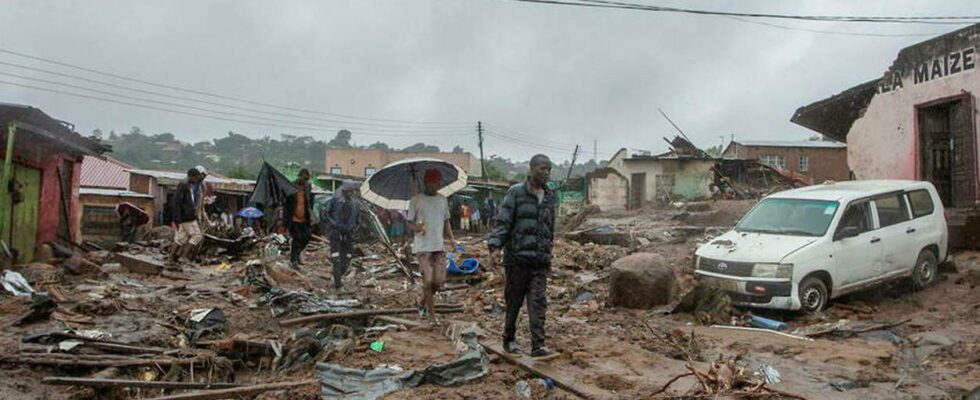Hopes of finding survivors are dwindling in Malawi and Mozambique, where the cyclone has ravaged entire towns and killed dozens of people.
IM with AFP
© AMOS GUMULIRA / AFP
Published on
Subscriber-only audio playback
ATs Malawi and Mozambique count their dead after Cyclone Freddy hit, the situation is dire for Malawian survivors, facing dire living and care conditions and a lack of food. In both countries, the toll of the cyclone, with record longevity and which struck twice in southern Africa in three weeks, exceeded 200 dead on Tuesday March 14, causing floods and landslides. Rescuers said they fear more casualties, as hope dwindles of finding survivors in ravaged towns and villages.
Freddy, following a looping path rarely charted by meteorologists, made landfall for the second time over the weekend in Mozambique and then headed south into neighboring Malawi early on Monday.
“We are helpless and no one is there to help us”
Authorities in Mozambique have reported 20 dead and 24 injured, while Malawi, the country that has so far paid the heaviest price for the return of the tropical cyclone, now has at least “190 dead, 584 injured and 37 missing”. the National Disaster Management Office said in a statement. A state of disaster has been declared in the region of Blantyre, the economic capital and epicenter of the bad weather.
In the township of Chilobwe, near Blantyre, residents remained stunned by the remains of houses washed away by the mudslides. The wind died down but the rain persisted. Constructions made of bricks and mud did not resist. “We are helpless and no one is there to help us”, launched John Witman, 80, soaked despite a raincoat and a woolen hat, who is looking for his son-in-law, who disappeared in the collapse of his house swept away by the sudden rising waters.
Residents say they believe dozens of bodies are still there, buried in the mud. Excavators have been deployed in some places. The day before, families and rescuers searched the ground with their bare hands.
Overwhelmed hospital
The hospital in the region is “overwhelmed by the influx of wounded”, alerted in a press release Doctors Without Borders, present on the spot. “Queen Elizabeth Central Hospital alone received 220 people, including 42 adults and 43 children who were declared dead on arrival.” The NGO fears in particular a jump in cholera cases in the country in lack of vaccines, which is already fighting against the epidemic of this most deadly infectious disease it has known.
A few kilometers away, in Chimkwankhunda, Steve Panganani Matera shows a huge field of dripping mud: “There were lots of houses here, all gone,” he told AFP, sheltered under a fragile umbrella.
Under a heavy sky, some try to cross the maroon waters which break from the top of the hills, on improvised bridges made of planks thrown between the scree. Nearly 59,000 people were affected in the country and nearly 20,000 displaced, urgently housed in schools or churches.
President Lazarus Chakwera, who returned Tuesday from Qatar, praised the efforts of the volunteers. “We have arrived in a devastated nation,” he lamented in a statement. South African President Cyril Ramaphosa said in a statement “saddened by the loss of life”.
Cyclone Freddy had already hit Mozambique
Freddy had hit southern Africa for the first time at the end of February. After an unprecedented crossing of more than 10,000 kilometers from east to west in the Indian Ocean, it made landfall in Madagascar before hitting Mozambique. The death toll was then 17. Recharging in intensity and humidity over the warm seas, Freddy then turned around, returning to swoop down on southern Africa two weeks later. He killed 10 last week while returning to Madagascar.
READ ALSOFloods in South Africa: this strong signal of climate changeThe cyclone returned “a little less intense than at its peak in the middle of the Indian Ocean but still with very strong winds and gusts at 200 km / h”, explained to AFP Emmanuel Cloppet, director of Météo- France for the Indian Ocean. “It is very rare that these cyclones feed again and again”, underlines Coleen Vogel, climate expert at the South African University of the Witwatersrand in Johannesburg, questioning climate change.
Freddy formed off Australia in early February and has been plaguing the Indian Ocean for 36 days. Tropical Cyclone John lasted 31 days in 1994. The South West Indian Ocean is hit by tropical storms and cyclones several times a year during the hurricane season which runs from November to April.
